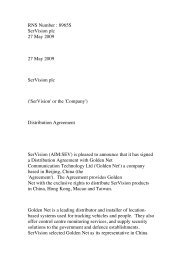TVG-Series System Guide v1-4 - SerVision
TVG-Series System Guide v1-4 - SerVision
TVG-Series System Guide v1-4 - SerVision
Create successful ePaper yourself
Turn your PDF publications into a flip-book with our unique Google optimized e-Paper software.
<strong>SerVision</strong><br />
<strong>TVG</strong> <strong>System</strong> <strong>Guide</strong><br />
and data between the <strong>TVG</strong> and clients. When you enable the proxy service on a <strong>TVG</strong>, the <strong>TVG</strong> initiates a<br />
connection with the proxy server and registers with it each time it connects to a network. Clients can then connect to<br />
the <strong>TVG</strong> indirectly by connecting to the proxy server. For additional information about proxy services in general<br />
and about proxy servers that are available for use please contact your vendor.<br />
DDNS is designed to facilitate internet connections to systems that use dynamic public IP addresses (see Appendix<br />
B: LAN Settings, page 200). When you enable a DDNS on a <strong>TVG</strong>, the <strong>TVG</strong> is assigned a name. The <strong>TVG</strong> registers<br />
with the DDNS service each time it connects to the internet, and relays its current public IP address to the service.<br />
Client applications connect to the <strong>TVG</strong> by using its name rather than its public IP address. The DDNS service<br />
ensures that the correct public IP address is linked to the name at all times, even when the IP changes.<br />
Three DDNS services are supported by the system: SV-DDNS (<strong>SerVision</strong>'s DDNS service), No-IP, and DynDNS.<br />
For information about the SV-DDNS service, consult your vendor. For information about the No-IP and DynDNS<br />
DDNS services, consult their websites (www.no-ip.com and www.dyndns.com).<br />
To adjust the Proxy and DDNS settings:<br />
1. In the Main Menu, under <strong>System</strong>, click Proxy & DDNS. The Proxy and DDNS Settings screen opens:<br />
Figure 57: Proxy and DDNS Settings screen<br />
2. If you are using a proxy for remote access, under Proxy, select Enabled. The fields required to configure the<br />
proxy settings are added to the screen.<br />
Figure 58: Proxy settings<br />
Fill in the fields as follows:<br />
Configuring <strong>System</strong> Settings 54





